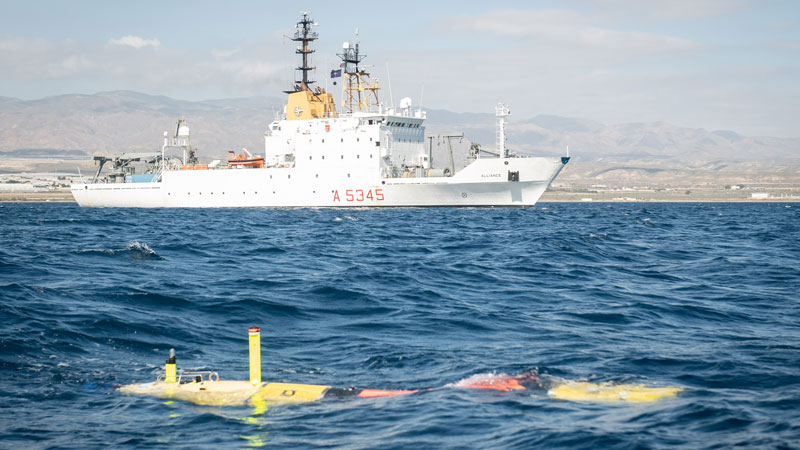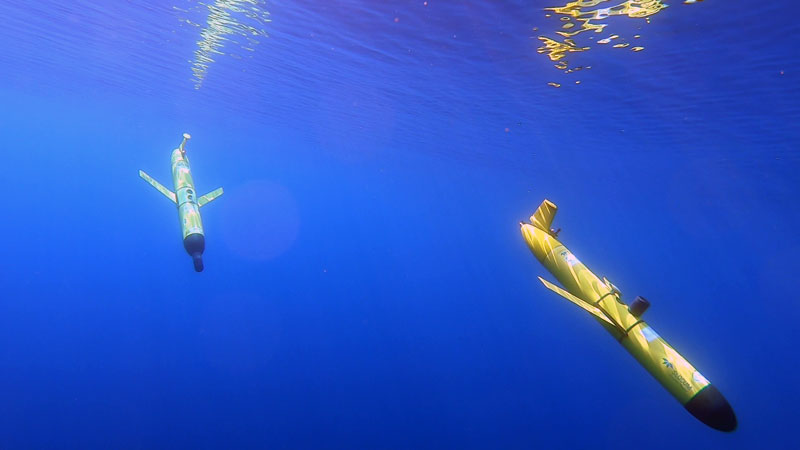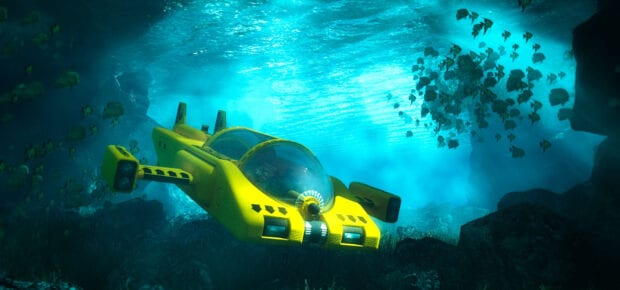September 3, 2020
Autonomous underwater vehicles (AUVs) play a valuable role in the maintenance and observance of our oceans, seas, rivers and lakes to ensure safety to our most valuable natural resources, as well as provide assistance to the divers who perform important tasks within the depths of our largest bodies of water.
We interviewed three IEEE Senior Members, Roberto Petroccia, Fausto Ferreira and Gabriele Ferri, who are also members of the IEEE Oceanic Engineering Society (OES). They currently work at the NATO Science and Technology Organization Centre for Maritime Research and Experimentation in La Spezia, Italy.
“AUVs can work for a long time without getting tired and at depths impossible for a diver,” Ferri said. “Divers can operate typically up to 60 meters, requiring use of special gases and tools when operating at higher depths. Additionally, the time they can spend at such a high depth is quite limited. However, the sea bottom goes much deeper (up to 11,000 meters) and many installations are below the operating depth of divers, such as oil rigs or communications pipelines.”
Essentially, vehicles and sensors are capable of covering and collecting data in larger areas, at greater depths and at quicker speeds than human divers and researchers. Plus, the deployment of a swarm of long-range and long endurance AUVs are capable of collecting environmental measurements without impacting marine life, says Ferreira.
“These systems of new generation can increase the spatial and temporal scale of the monitoring and can provide the persistence and synopticity (measurements at different locations at the same time),” says Petroccia. “This is crucial for understanding the state of the sea and for tracking ongoing phenomena, such as an oil spill or an algal bloom.”
This important type of research is only possible through the use of AUVs because surface ships and oceanographic observatories can only collect measurements in a single point.
To further their sustainability efforts through passive data collection, technologists who create AUVs often draw their creative designs from nature itself. “Many designs mimic marine life, such as jellyfish or fish, to optimize the efficiency of navigation taking inspiration by nature,” says Petroccia. “Other shapes, such as octopus have become a source of inspiration to support manipulators that are able to work without damaging the marine ecosystem, such as when working in the coralline reefs or when monitoring clams.”

photo courtesy of CMRE
How Does an Autonomous Underwater Vehicle Work?
When we think of autonomous technology, the first thing that comes to mind is often a vehicle found on the highway. While some of the technologies are similar to a car, AUVs must have a complex system because of the hostile environment the robot must endure in the water.
“Global navigation satellite system (GNSS) is not available [underwater]”, says Ferreira. “This makes underwater robot self-localization challenging and still an open issue in the research community. Doppler velocity logs can measure the speed of the robot with respect to the seafloor, but only when the robot is not navigating too high from the bottom.”
Another difference of an AUV from an autonomous car is that a gasoline or diesel engine cannot be submerged underwater because of the lack of oxygen. Ferri explains that this challenge has actually pushed technologists to turn to cleaner propulsion technologies, “such as fuel cells that increase their endurance with respect to typical lithium batteries.”
Technologists also face the challenge of efficient communication and sensing underwater. Their reliable solution is to utilize the acoustics underwater. “Acoustic communications enables us to exchange data over long distances (up to tens of kilometers) but with a low data rate (typically few hundreds of bits per second or up to few kilobits per seconds) and long propagation delays,” says Petroccia. “This is very different with respect to what is experienced in terrestrial wireless radio networks, requiring to design novel communications solutions and networking protocols. This dictates that AUVs need to become more and more autonomous to accomplish their missions, since a direct and reliable link with a pilot cannot be guaranteed.”
See also What Do Oceans Reveal about Marine Health, Earth’s Resources, and Space Travel?

photo courtesy of CMRE
AUVs are Keeping Our Oceans Clean and Spill-Free
The gas and oil industry is beginning to tap into the technology and advantages of AUV monitoring, inspection, maintenance and even intervention in reducing chemical and oil spills in our oceans.
“Several solutions have been proposed to allow AUVs following in an autonomous way along pipelines on the seabed, thus inspecting the thickness and status of the pipes, and detecting possible leakage of oil and gas,” says Ferri. “Additionally, there is a growing interest in deploying resident subsea systems which are capable of inspecting, maintaining and repairing the required equipment.”
AUVs and marine robots are also capable of helping during the oil clean-up process as well. “Oil tends to submerge with the passing of time,” says Ferreira. “AUVs can follow the plume, study the phenomena and localize the leak source. For instance, one expedition characterized subsurface oil plumes extending from the Deepwater Horizon (the massive accident that happened in the Gulf of Mexico in 2010) using novel technology and the latest in biogeochemical techniques.”
What is the Future of Autonomous Underwater Vehicles?
The IEEE OES sponsors the Autonomous Underwater Vehicle Symposium, which has gathered every two years since the 90s to discuss the future of AUVs and celebrate the successes of those in the industry who make a difference in our seas. The conference even has a contest for students to provide conceptual designs of a low-cost AUV to stimulate innovation among the younger generation.
Yet, AUV2020 is going to look a little different this year. The conference will run from September 30- October 2 and be completely remote because of the restraints that COVID-19 has placed on large gatherings.
The conference will address topics ranging from how machine learning is used to estimate the risk of AUV loss to how advanced sampling devices are integrated into autonomous vehicles. This trio of IEEE Senior Members plan to participate in AUV2020 by sharing a paper about EUMarineRobots (EUMR) and looks forward to learning about the use of machine learning and artificial intelligence support in AUVs operations and the usage of AUVs in polar regions.
Learn more about AUV2020 here.

 Liquid Infrastructure: Our Planet's Most Precious Resource
Liquid Infrastructure: Our Planet's Most Precious Resource The Impact of Technology in 2025
The Impact of Technology in 2025 Quantum and AI: Safeguards or Threats to Cybersecurity?
Quantum and AI: Safeguards or Threats to Cybersecurity? Why AI Can't Live Without Us
Why AI Can't Live Without Us Bits, Bytes, Buildings and Bridges: Digital-Driven Infrastructure
Bits, Bytes, Buildings and Bridges: Digital-Driven Infrastructure Impact of Technology in 2024
Impact of Technology in 2024 Emerging AI Cybersecurity Challenges and Solutions
Emerging AI Cybersecurity Challenges and Solutions The Skies are Unlimited
The Skies are Unlimited Smart Cities 2030: How Tech is Reshaping Urbanscapes
Smart Cities 2030: How Tech is Reshaping Urbanscapes Impact of Technology 2023
Impact of Technology 2023 Cybersecurity for Life-Changing Innovations
Cybersecurity for Life-Changing Innovations Smarter Wearables Healthier Life
Smarter Wearables Healthier Life Infrastructure In Motion
Infrastructure In Motion The Impact of Tech in 2022 and Beyond
The Impact of Tech in 2022 and Beyond Cybersecurity, Technology and Protecting Our World
Cybersecurity, Technology and Protecting Our World How Technology Helps us Understand Our Health and Wellness
How Technology Helps us Understand Our Health and Wellness The Resilience of Humanity
The Resilience of Humanity Harnessing and Sustaining our Natural Resources
Harnessing and Sustaining our Natural Resources Creating Healthy Spaces Through Technology
Creating Healthy Spaces Through Technology Exceptional Infrastructure Challenges, Technology and Humanity
Exceptional Infrastructure Challenges, Technology and Humanity The Global Impact of IEEE's 802 Standards
The Global Impact of IEEE's 802 Standards Scenes of our Cyber Lives: The Security Threats and Technology Solutions Protecting Us
Scenes of our Cyber Lives: The Security Threats and Technology Solutions Protecting Us How Millennial Parents are Embracing Health and Wellness Technologies for Their Generation Alpha Kids
How Millennial Parents are Embracing Health and Wellness Technologies for Their Generation Alpha Kids Space Exploration, Technology and Our Lives
Space Exploration, Technology and Our Lives Global Innovation and the Environment
Global Innovation and the Environment How Technology, Privacy and Security are Changing Each Other (And Us)
How Technology, Privacy and Security are Changing Each Other (And Us) Find us in booth 31506, LVCC South Hall 3 and experience the Technology Moon Walk
Find us in booth 31506, LVCC South Hall 3 and experience the Technology Moon Walk Virtual and Mixed Reality
Virtual and Mixed Reality How Robots are Improving our Health
How Robots are Improving our Health IEEE Experts and the Robots They are Teaching
IEEE Experts and the Robots They are Teaching See how millennial parents around the world see AI impacting the lives of their tech-infused offspring
See how millennial parents around the world see AI impacting the lives of their tech-infused offspring Take the journey from farm to table and learn how IoT will help us reach the rising demand for food production
Take the journey from farm to table and learn how IoT will help us reach the rising demand for food production Watch technical experts discuss the latest cyber threats
Watch technical experts discuss the latest cyber threats Explore how researchers, teachers, explorers, healthcare and medical professionals use immersive technologies
Explore how researchers, teachers, explorers, healthcare and medical professionals use immersive technologies Follow the timeline to see how Generation AI will be impacted by technology
Follow the timeline to see how Generation AI will be impacted by technology Learn how your IoT data can be used by experiencing a day in a connected life
Learn how your IoT data can be used by experiencing a day in a connected life Listen to technical experts discuss the biggest security threats today
Listen to technical experts discuss the biggest security threats today See how tech has influenced and evolved with the Games
See how tech has influenced and evolved with the Games Enter our virtual home to explore the IoT (Internet of Things) technologies
Enter our virtual home to explore the IoT (Internet of Things) technologies Explore an interactive map showcasing exciting innovations in robotics
Explore an interactive map showcasing exciting innovations in robotics Interactively explore A.I. in recent Hollywood movies
Interactively explore A.I. in recent Hollywood movies Get immersed in technologies that will improve patients' lives
Get immersed in technologies that will improve patients' lives